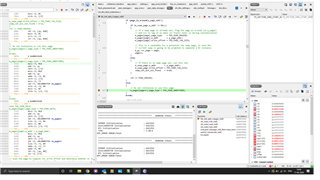Hello Guys,,
I am trying to migrate my project form keil to segger embedded studio. My product is based on sdk 12.2.0, using softdevice s130 on nrf51822.
I searched for all the posts that helped in migrating to SES and able to successfully build my application project. But when flashing the build to my board
it is getting stuck at nrf_dfu_flash_erase function in dfu_init
I tried debugging and it is giving the error FS_ERR_INVALID_CFG in check_config(p_config) function. searched for the solution in the forum posts but nothing helped so far.
please help us to resolve as we are nearing production.
I am attaching my flash placement file for your reference
<!DOCTYPE Linker_Placement_File>
<Root name="Flash Section Placement">
<MemorySegment name="$(FLASH_NAME:FLASH)">
<ProgramSection alignment="0x100" load="Yes" name=".vectors" start="$(FLASH_START:)" />
<ProgramSection alignment="4" load="Yes" name=".fs_data" />
<ProgramSection alignment="4" load="Yes" name=".init" />
<ProgramSection alignment="4" load="Yes" name=".init_rodata" />
<ProgramSection alignment="4" load="Yes" name=".text" />
<ProgramSection alignment="4" load="Yes" name=".dtors" />
<ProgramSection alignment="4" load="Yes" name=".ctors" />
<ProgramSection alignment="4" load="Yes" name=".rodata" />
<ProgramSection alignment="4" load="Yes" name=".ARM.exidx" address_symbol="__exidx_start" end_symbol="__exidx_end" />
<ProgramSection alignment="4" load="Yes" runin=".fast_run" name=".fast" />
<ProgramSection alignment="4" load="Yes" runin=".data_run" name=".data" />
<ProgramSection alignment="4" load="Yes" name=".bootloaderSettings" />
<ProgramSection alignment="4" load="Yes" runin=".tdata_run" name=".tdata" />
<ProgramSection alignment="4" keep="Yes" load="Yes" runin=".fs_data_run" name=".fs_data" />
</MemorySegment>
<MemorySegment name="$(RAM_NAME:RAM);SRAM">
<ProgramSection alignment="0x100" load="No" name=".vectors_ram" start="$(RAM_START:$(SRAM_START:))" />
<ProgramSection alignment="4" load="No" name=".fast_run" />
<ProgramSection alignment="4" load="No" name=".data_run" />
<ProgramSection alignment="4" load="No" name=".bss" />
<ProgramSection alignment="4" load="No" name=".tbss" />
<ProgramSection alignment="4" load="No" name=".tdata_run" />
<ProgramSection alignment="4" load="No" name=".non_init" />
<ProgramSection alignment="4" size="__HEAPSIZE__" load="No" name=".heap" />
<ProgramSection alignment="8" size="__STACKSIZE__" load="No" place_from_segment_end="Yes" name=".stack" />
<ProgramSection alignment="8" size="__STACKSIZE_PROCESS__" load="No" name=".stack_process" />
<ProgramSection alignment="4" size="__STACKSIZE__" load="No" name=".fs_data_run" address_symbol="__start_fs_data" end_symbol="__stop_fs_data" />
<ProgramSection alignment="4" keep="Yes" load="No" name=".fs_data_run" address_symbol="__start_fs_data" end_symbol="__stop_fs_data" />
</MemorySegment>
<MemorySegment name="$(FLASH2_NAME:FLASH2)">
<ProgramSection alignment="4" load="Yes" name=".text2" />
<ProgramSection alignment="4" load="Yes" name=".rodata2" />
<ProgramSection alignment="4" load="Yes" runin=".data2_run" name=".data2" />
</MemorySegment>
<MemorySegment name="$(RAM2_NAME:RAM2)">
<ProgramSection alignment="4" load="No" name=".data2_run" />
<ProgramSection alignment="4" load="No" name=".bss2" />
</MemorySegment>
</Root>



